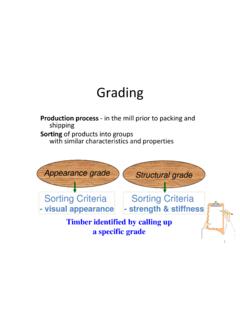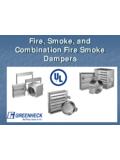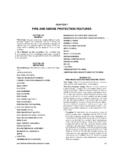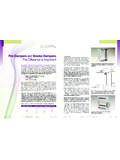Transcription of Content of Presentation - boeingconsult.com
1 1. Content of Presentation Slide 3 Combustion Slide 4 fire Triangle Slide 5 fire Tetrahedon Slide 6 Adiabatic flame temperature Slide 7 The Four Stages of a fire Slide 15 Products of Combustion Slide 16 Principle of fire Extinction Slide 18 The Strategy of Preventing a fire Slide 19 Causes of Ignition Slide 20 Flammable and combustible liquids Slide 21 How do I tell what's flammable? Slide 22 Storage Guidlines 2. What is combustion ? Combustion is the act or process of burning. For combustion to occur, fuel, oxygen (air), and heat must be present together. The combustion process is started by heating the fuel above its ignition temperature in the presence of oxygen. Under the influence of heat, the chemical bonds of the fuel are split. If complete combustion takes place, the elements carbon (C), hydrogen (H).
2 And sulphur (S) react with the oxygen Content of the air to form carbon dioxide CO2, water vapour H2O and sulphur dioxide SO2 and, to a lesser degree, sulphur trioxide SO3. Back to top 3. fire Triangle Fuel + Oxygen + Heat = fire The fire TRIANGLE represents the three elements needed for fire to occur: heat, fuel, and oxygen. The air we breathe Heat is the energy is about 21% necessary to increase oxygen. fire the temperature of requires an the fuel to a point atmosphere with at where sufficient vapors least 16% oxygen. are given off for ignition to occur. Fuel can be any combustible material in any state of matter - solid, liquid, or gas. Most solids and liquids become a vapor or gas before they will burn. Back to top 4. fire Tetrahedron 1. There must be Fuel to burn.
3 Any combustible material - solid, liquid or gas. Most solids and liquids must vaporise before they will burn. 2. There must be Air to supply Oxygen. Sufficient oxygen (at least 16%) must be present in the atmosphere surrounding the fuel for fire to burn. This is usually not a problem since the air we breathe is about 21% oxygen. 3. There must be Heat (ignition temperature) to start and continue the combustion process. Sufficient heat energy must be applied to raise the fuel to it's ignition temperature However by adding in a fourth element, you have a fire "tetrahedron". 4. CHEMICAL CHAIN REACTION - This reaction can occur when all three of the above elements are present in the proper conditions and proportions. fire (rapid oxidisation). is the result of this chemical reaction.
4 5. ADIABATIC FLAME TEMPERATURE. Adiabatic is a term used to describe a combustion reaction in which all heat generated is retained in the products of combustion. Adiabatic flame temperature is the theoretical temperature that would be attained by the products of combustion provided the entire chemical energy of the fuel is transferred to the products of combustion. This assumes that there is no heat loss to surroundings and no dissociation Dissociation is a reaction involving the breakdown of chemical compounds. In the case of combustion, these are water vapour and carbon dioxide. Back to top 6. The Four Stages of a fire 1 INCIPIENT STAGE. 2 GROWTH STAGE. 3 FULLY DEVELOPED STAGE. 4 DECAY STAGE. Back to top 7. Incipient Stage Going back to the basics of fire behavior, ignition requires heat, fuel, and oxygen.
5 Once combustion begins, development of an incipient fire is largely dependent on the characteristics and c Heat Release Rate (HRR) and fire Development Fires barely follow the simple, idealized fire development curve as illustrated in Figure 1. Peak heat release rate, and duration of burning are dependent on: the characteristics of the fuel and the ventilation profile (available oxygen). 8. Figure 1. 1.) INCIPIENT STAGE. Earliest of the four phases of a fire . Development of a fire is largely dependent on the fuel involved fire can be controlled or extinguished by portable fire extinguishers No detectable flame at this stage Smoke particles are released into the atmosphere. The layer of hot gases becomes more clearly defined and increases in volume The fire nears the growth stage.
6 9. 2.) GROWTH STAGE. Earliest stage of a fire beginning with actual ignition. fire limited to origin of ignition material. Flame temperature may be well above 540 C. Some heat being generated. Amount of heat will increase with the progress of the fire . Sufficient oxygen and fuel are available for fire growth to a point where total involvement is possible. Heat carried to uppermost region of confined area. Heated gases spread laterally from the top and then down. Cooler air forced to lower levels. Upper region can exceed 700 C. 10. THERMAL BALANCE. Heated gases move to the upper levels of a room. Highest temperatures will be at the ceiling, and lowest temperatures and best visibility will be at ground level. Sporadic flashes of flame mixed with smoke at the upper ceiling level just before flashover occurs 11.
7 FLASHOVER. Simultaneous ignition of all contents of the compartment. Normally occurs when the upper gas layer reaches 600 C. Flashover can also occur in the space above the fire . Can usually be prevented by proper fog application or venting. 12. 3.) FULLY DEVELOPED STAGE. All combustibles in the space have reached their ignition temperature. Burning rate limited by the amount of oxygen available in the air for combustion. Unburned fuel in the smoke may burn as it meets fresh air in adjacent compartments. Structural damage to exposed steel normally occurs. Normally inaccessible by hose teams. Best fought using indirect attack. 13. 4.) DECAY STAGE. Available oxygen is consumed or reduced to a point where there is insufficient oxygen to react with fuel. Flame may cease to exist if the area is sufficiently airtight.
8 Burning reduced to glowing embers If fire continues to smolder, compartment will fill with dense smoke and gases and temperatures could reach well over 10000C. Intense heat and high concentration of fire gases could produce suitable conditions for a backdraft explosion. 14. PRODUCTS OF COMBUSTION. When a material (fuel) burns, it undergoes a chemical change. None of the elements making up the material are destroyed in the process, but all of the matter is transformed into another form or state. When a fuel burns there are four products of combustion: 1. fire gases gaseous part of combustion product(s). 2. Flame Flame is the visible, luminous body of a burning gas. 3. Heat Heat is a form of energy that is measured in degrees of temperature to signify its intensity.
9 4. Smoke Smoke at most fires consists of a mixture of oxygen, nitrogen, carbon dioxide. Back to top 15. Principle of fire Extinction The principles of fire extinction consist of the elimination or removal of one or more of the four elements. These principles are: COOLING. The most commonly used fire fighting medium is water. Water absorbs heat from the fire and cools the fuel to a temperature where it no longer produces flammable vapors. SMOTHERING. By excluding the oxygen in the surrounding atmosphere, the fire will be extinguished. Back to top 16. Principle of fire Extinction (cont.). STARVATION. Starvation is achieved by removal of the fuel burning in the fire . Sometimes combustible material can be removed such as by shutting off gas valves or fuel flows. STOP CHAIN REACTION.
10 Stop or interrupt the chain reaction between the fuel, heat and oxygen the fire will be extinguished. Specific methods of extinguishing fires often involve a combination of more than one of the four principles 17. The Strategy of Preventing a fire A fire must have three things to ignite and maintain combustion: Fuel Heat Oxygen The basic strategy of fire prevention is to control or isolate sources of fuel and heat in order to prevent combustion. If all three are not present in sufficient quantities a fire will not ignite or a fire will not be able to sustain combustion Back to top 18. Causes of Ignition Flammable materials may ignite in many ways, some familiar, some less so. The most common ignition source is flame. Hot surfaces can also cause fire Sparks generate very high temperatures in a very small space, but it is rare that a spark will cause ignition in the absence of other factors.










